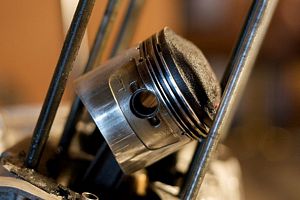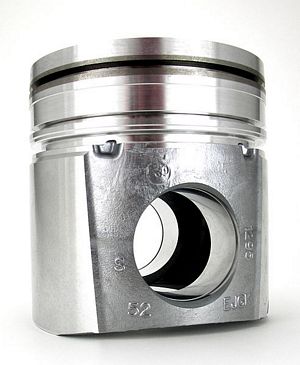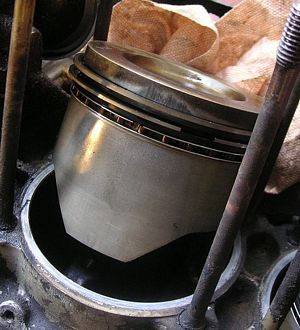|
By accessing or using The Crittenden Automotive Library™/CarsAndRacingStuff.com, you signify your agreement with the Terms of Use on our Legal Information page. Our Privacy Policy is also available there. |

Pistons Have Rings? The Most Important Part in Your Engine
|
|---|
|
|
Pistons Have Rings? The Most Important Part in Your Engine
David Lye
October 24, 2012
Piston rings are one of the most important parts in your engine, yet hardly any attention is paid to them. To use an NFL analogy, they are the offensive linemen of the modern engine – rings don't get a lot of love, but you can't move without them.
Piston rings perform three key functions:
1. Seal in combustion pressure.
2. Lubricate the cylinder wall so the pistons can glide up and down freely
3. Transfer heat from the combustion chamber into the cylinder wall, where it then dissipates into the coolant passages
Amazingly, piston rings can help dissipate as much as 70% of the heat in the pistons, which is substantial considering that piston rings are relatively tiny when compared to the piston.
Ring Design Requirements
In any case, piston rings can only perform these functions if they maintain contact with the cylinder wall. This is easier than it sounds, as there are a number of forces that are working to separate the ring from the cylinder wall.
For example: When pressure from the combustion chamber presses down on the piston ring, it causes “pressure twisting,” an uneven application of combustion chamber forces that – unchecked – will allow combustion chamber gases to blow by the rings. Blow-by is bad because it reduces engine power, and if it happens on a regular basis, it will cause damage.
Pressure twisting is also bad for rings because it increases cylinder wall friction, which increases ring wear, increases the odds of cylinder wall scuffing, and decreases fuel economy. Over time, ring wear and cylinder wall scuffing lead to oil use, reduced engine power, and poor fuel economy. So, a well-designed engine ring is strong enough to resist twisting while simultaneously flexible enough to adapt to imperfections in the cylinder wall.
Other challenges that face piston rings include:
• Detonation, which refers to premature combustion, causes powerful vibrations in the ring that can lead to permanent damage
• Inadequate cooling or lubrication, due to poor maintenance, can also lead to permanent damage
• Piston rings can also “microweld,” which happens when temperatures inside the combustion chamber get so high that the rings essentially weld themselves to the piston and lose all flexibility.
How Long Do Piston Rings Last?
Despite all of the design requirements, piston rings have never been better. A modern engine uses three rings to seal the chamber, lube the cylinder wall, and dissipate heat. A thin, flexible top ring is designed to conform to the cylinder wall and provide a combustion chamber seal. A thicker, slightly less flexible ring also helps to seal the chamber. A third ring (it's actually a pair of rings spaced very closely together) ensures that the correct amount of oil is routed to the first two rings, while returning any excess oil to the crankcase. Steel alloys and ductile iron are typically used to make rings, as they have the right combination of durability, stability, and heat resistance to last. These improvements mean that contemporary piston rings in a well-maintained and well-cared-for engine will last hundreds of thousands of miles with minimal wear. Compared to the cast-iron rings of the old days – which wore relatively quickly and often broke during normal engine operation – this is a giant leap forward.
What's more, continuous innovation in piston ring design and construction has reduced cylinder wall friction substantially. Special coatings on the ring and the cylinder wall reduce friction and wear, which in turn improves fuel economy. As a matter of fact, reducing internal engine friction on parts like the piston rings, cam and crankshafts can improve fuel economy as much as 3% on a larger engine.
If you've read closely, you know more about piston rings than 90% of the population. Congratulations!
Author David Lye is the director at PrivateFleet.com.au, a car buying service based in Australia. When David isn't writing about piston rings, he's working on his favorite project car.




















